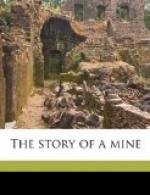Garcia comes next. That gentleman’s inborn talent for historic misrepresentation culminated unpleasantly through a defective memory; a year or two after he had sworn in his application for the “Rancho,” being engaged in another case, some trifling inconsistency was discovered in his statements, which had the effect of throwing the weight of evidence to the party who had paid him most, but was instantly detected by the weaker party. Garcia’s preeminence as a witness, an expert and general historian began to decline. He was obliged to be corroborated, and this required a liberal outlay of his fee. With the loss of his credibility as a witness bad habits supervened. He was frequently drunk, he lost his position, he lost his house, and Carmen, removed to San Francisco, supported him with her brush.
And this brings us once more to that pretty painter and innocent forger whose unconscious act bore such baleful fruit on the barren hill-sides of the “Red-Rock Rancho,” and also to a later blossom of her life, that opened, however, in kindlier sunshine.
CHAPTER IX
WHAT THE FAIR HAD TO DO ABOUT IT
The house that Royal Thatcher so informally quitted in his exodus to the promised land of Biggs was one of those oversized, under-calculated dwellings conceived and erected in the extravagance of the San Francisco builder’s hopes, and occupied finally in his despair. Intended originally as the palace of some inchoate California Aladdin, it usually ended as a lodging house in which some helpless widow or hopeless spinster managed to combine respectability with the hard task of bread getting.
Thatcher’s landlady was one of the former class. She had unfortunately survived not only her husband but his property, and, living in some deserted chamber, had, after the fashion of the Italian nobility, let out the rest of the ruin. A tendency to dwell upon these facts gave her conversation a peculiar significance on the first of each month. Thatcher had noticed this with the sensitiveness of an impoverished gentleman. But when, a few days after her lodger’s sudden disappearance, a note came from him containing




